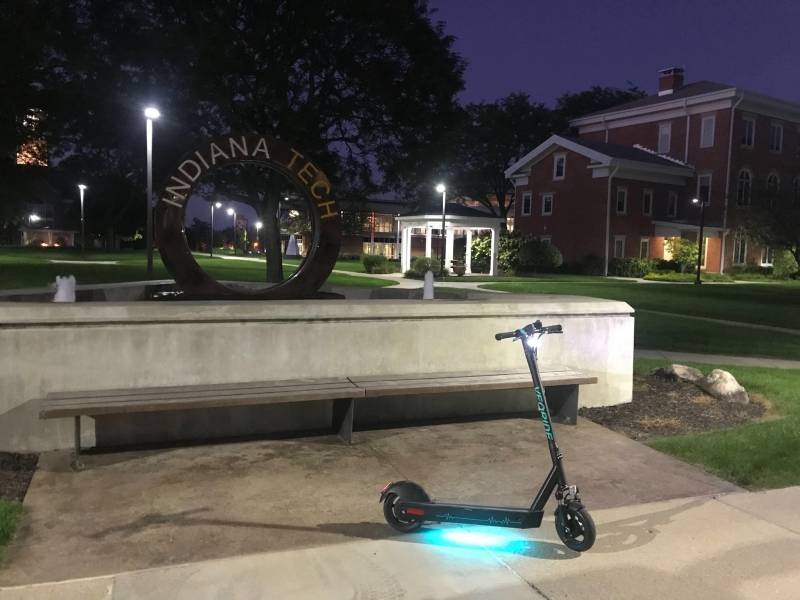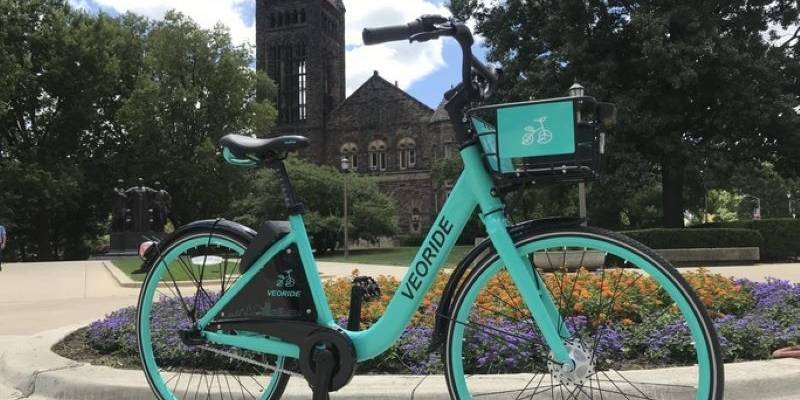We’ve recently passed the year anniversary of bike sharing becoming a part of Champaign-Urbana and the University of Illinois campus, with the arrival of VeoRide, a dockless mobility share company. VeoRide was here as a yearlong pilot program, and they’ve just been renewed for a second year. There have been over 300,000 rides on the allotted 500 bikes, which were initially all standard bicycles, but now a large percentage have been replaced with electric versions. Ben Thomas, the Midwest General Manager for VeoRide, hopes to increase that number and make the bikes a permanent transportation option in the community. Right now they are the sole company providing bike sharing here, which is something that has been debated in Champaign City Council. The service is not without issues, which usually involve users not properly parking the bikes. That’s one problem that is stalling the prospect of adding electric scooters to the fleet, something Thomas and his team are working toward, along with concerns over safety. Scooters, including VeoRide scooters, have already become a presence in other cities.
I spoke with Thomas a few weeks ago about how this new thing has fared in C-U over the past year.
Smile Politely: Can you tell me about VeoRide in the context of the bike sharing universe? I know that there has been discussion in the respective city councils about opening the possibility of other companies establishing themselves here. What sets Veoride apart?
Ben Thomas: There are two big things. One is distributors. Compared to every other competitor that we have, we have a direct line distributor. We make all of our products. We make commercial grade products that we design, we’re constantly coming up with new generations of bikes and scooters. We’re ahead of the curve in that sense. We’re heavily tech-focused. Lime is one of our big competitors that has a heavy tech focus as well, so we consider ourselves to be pretty equal with them when it comes to overall focus and vision, of how we want to be on the cutting edge of technology and the capabilities that we have.
SP: What was the motivation to bring this service to Champaign- Urbana?
Thomas: Infrastructure is huge, and topography makes a big difference, because it’s so flat. Also community size, with a Big Ten school that has over 45,000 students. You also have a huge biking community. You have tons of bike lanes, which makes our job easier, because you have the infrastructure built to handle bikeshare. Those are some key factors when we look into a market: what’s the expectation for ridership, how can we grow it long term, what’s the vision of it for 2-5 plus years, how do we help improve infrastructure in the community in general. Every month we do updates with the city planners and campus planners, providing them with numbers, metrics that cover average riding time, miles ridden, and also “heat maps” with popular pick up and drop off locations.
SP: I would assume most of the usage is on the U of I’s campus, but are there other parts of the community that see a good amount of use?
Thomas: It’s spread out: downtown Champaign and downtown Urbana you have some drop off spots, Marketplace is a huge dropoff spot, anywhere up there near Walmart, Target, as well as any of the local food places near there. Our “big square” ridership is pretty much Windsor to Prospect to Bradley to Lincoln. That’s the box that most of our ridership stays in.
Photo from MTD Twitter page
SP: I just saw you quoted in a news story about the illegal parking of the bikes. Do you feel like your team here has to deal with that a lot? You would think it would be common sense, but how do you educate people about proper usage?
Thomas: We try to be as proactive as possible, and that’s why we have our local operations team: 10 guys working for us around the clock — we’re a 24/7 operation — addressing the concerns of bikes blocking the sidewalks or people parking inappropriately. One of the reasons we have an operations team is to have those guys on the ground ready to respond to customer service calls within 30 minutes (the pilot agreement stipulates they need to respond within three hours). We know every market that we go into these growing pains happen. Last September/October tons of calls were coming in because it was new. Now we don’t see that. City planners get maybe one or two calls a month. We also implement fines for people who are repeat offenders. When a bike gets called in I track down that last user, and from there we can give them a text or a call and say “hey, you parked inappropriately, here’s your warning.” We’ve kicked people out of our system before because they are repeat offenders and they just don’t care. We want people to park in bike racks as much as possible, but we want mobility to increased instead of regulated and decreased. That’s why you don’t have a docking system. Docking systems cost a lot of money to put in, and it decreases mobility and freedom for people to get around.
SP: What’s the appropriate way for people to park the bikes if there’s not a bike rack available?
Thomas: We always want to make sure that people aren’t putting them in their houses or in their yards. We get probably 10 calls a month about private property and bikes there, and we just go pick them up and the issue is solved. In the communities you are allowed to park the bikes in a parking spot (on the street, like you would with a car), and we want to encourage that. All of people don’t know that. You can park on the sidewalk off to the side, but in some subdivisions sidewalks are really narrow, so then it’s still impeding someone walking and we don’t want that. We don’t have a ton of those calls that come in each week, because I think people have learned over time.
SP: How often do you deal with damaged or stolen bikes?
Thomas: This market has a decent vandalism rate, whether intentional or not. In a high ridership market like this you’re going to have those issues. We have a staff that keeps up with repairing bikes, we have a reporting system in the app so we check that every day and every night and go out and collect those bikes, fix them, and get them back out on the streets. It’s a pretty consistent ebb and flow. As we look into our business plan and model long term: how do we improve the design of our bikes to make them more durable long term, but also educate users?
 Photo from VeoRide Facebook page
Photo from VeoRide Facebook page
SP: I understand that scooters are (possibly) on the horizon. Can you tell me more about what’s happening there?
Thomas: Obviously we’d love to have scooters here. Both mayors have been on scooters, some in the community have been on our scooters in Chicago…I’ve done a lot of work just to put it out there, sent data to the city councils, so they know what we’re doing in other markets like Knoxville and Tallahassee, so we’re on the radar. As of right now the campus is pretty much a no on scooters, so we’re kind of in a holding pattern. Conversations have kind of just stopped at this point. So we’re working with students to showcase, “hey this is another mode that you can use to get to class.” We ultimately want to serve students and the community in any way we can, and I know that’s what the university wants as well. It’s just working out what those next conversations are, how scooters would work with the infrastructure here, and how our specific scooters would be a benefit instead of a hindrance.
SP: Why add scooters to the mix?
Thomas: You have another audience who are not avid bike riders, so it’s trying to provide every potential user with the mode of transportation they would love to have to get from point A to point B. We have a little over 10,000 users with the bikes, which means there’s still 30 to 40 thousand just when it comes to students, so how do we reach them, how do we get them on one of our products. There’s always room to grow.
*****
What are your thoughts? Have you ridden one of the bikes over the past year? Would you like to see scooters added to the fleet? One of our writers tested out one of the bikes last year, you can read his review here.
Top photo from VeoRide website








